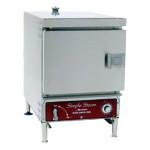
Commercial steamers use either circulated or pressurized hot steam to quickly cook food items. Steamers are ideal for cooking rice, vegetables, fish, and shellfish.
Because food is cooked by circulating hot steam over it, most nutrients are retained, making steam cooked food appear more appetizing and taste better.
Food is also cooked much more quickly using a steamer.
There are different types of steamers using different methods to cook food. Selecting the steamer that works for you depends on the specific situation in your commercial kitchen or restaurant.
Steamers also come in various sizes, and you need to take into account the volume you plan to handle with your steamer before purchasing one.
Types of Steamers
[unordered_list style=”green-dot”]- Pressureless – these steamers use a convection fan to circulate steam through the unit and cook food. The circulating air cooks more evenly than a pressure steamer, though cooking times are longer. A pressureless steamer door can also be opened during cooking to check or season food.
- Pressure – pressure steamers cook food by letting steam pressure build in the unit as opposed to circulating it. This cooks food faster but the door or lid of the unit cannot be opened while cooking because of the pressurized steam.
There are two types of pressure steamers: cabinet type and steam kettle models.
Cabinet type models look and operate mostly like a pressureless steamer except they use pressurized steam to cook food rather than a convection fan.
Countertop steam kettles operate like a residential pressure cooker.
Connection vs. Boilerless
Most countertop steamers are boilerless, meaning you add water to a built in reservoir in the bottom of the unit with its own heating element.
Connection steamers have a direct water line that comes in to the steamer from the building’s water source. This steamer type can handle higher volumes but is harder to clean and maintain.
Both types should use only filtered water with a scale inhibitor to reduce cleaning and maintenance. Using unfiltered water can also affect food taste.
Combi Ovens
Combi ovens can use steam, standard convection, or a combination of the two to cook food very quickly and efficiently. Although combi ovens are very expensive, they can replace many other standard restaurant equipment pieces like fryers, holding and warming cabinets, and of course steamers and convection ovens.
Combi ovens also save space because they can replace other restaurant equipment.
Calculating Steamer Size
Steamers (excluding kettle steamers) come in 1, 2, 3, or 4 compartment sizes, with a one compartment unit capable of producing up to 200 meals per hour. Combi ovens are most often used in high volume situations because they can cook food so quickly and offer multiple cooking options.
Maintenance and Operation Tips For Steamers
Some maintenance and operation tips for your commercial steamers:
[unordered_list style=”green-dot”]- Use filtered water with a scale inhibitor. A scale inhibitor removes minerals from tap water. These minerals can build up in your steamer, requiring constant cleaning and performance problems. Some models have an indicator light alerting you when they need to have buildup cleaned. Unfiltered water can also affect the taste of food cooked in steamers.
- Preheat steamers before cooking food. It usually takes at least 5 minutes for a steamer to heat up.
- Season food after it has been cooked in a steamer for best taste results.
- Use a perforated pan for vegetables and break up frozen vegetables so they cook evenly.
Steamers are a great addition to any commercial kitchen, and because they are much more energy efficient than other conventional cooking equipment like ranges, you can make up for the cost of purchasing a steamer through energy savings.
Factor in optimized food taste and quick cooking, and the reasons for buying a commercial steamer become very clear.
Check out more restaurant equipment.
 Corner Booth Blog | TundraFMP Restaurant Supply, News & Equipment Blog
Corner Booth Blog | TundraFMP Restaurant Supply, News & Equipment Blog




Serous thought should be given to maintenance issues with steamers. The post already warns of water filtering issues, but let me also add that as far as I know there is no standard water filter that will remove all the scale and minerals from any given water supply. There is some preventive maintenance issues with steamers that are not a factor with other equipment. The parts are VERY expensive and you will might have a hard time finding trained repair people to work on them.
A boiler on a standard 2 compartment pressure steamer will run you around $5000.00. That in addition to a LOT of labor to install it. I would suggest you keep a close eye on the inside of the boiler (every 3 months take off the hand plate and inspect with a flashlight). If you don’t think you are up to this task, then pay a company to do it for you. Wonderful as they are, a steamer can be a dangerous piece of equipment if it is not maintained.
Kevin Loving
Galveston Texas (where, if you can fix a steamer, you become the Chef’s hero!!)
That’s a great point Kevin. Boiler maintenance has been the achilles heel of owning a steamer in the past. I’d recommend taking a look at the StratoSteam steamers from Southbend. These models have no fan, no blower and no boiler. When these models first came out they had one at a show I attended with the side panel off showing the simplicity of the design. What you saw was some tubing, a solenoid and some other odds and ends. From what I understand Southbend has been having great success with these units.
I have not had a look at that Don, but if it don’t have a boiler it would get my vote!! I will look it up on the Internet and see what I can learn.
I don’t know if you can post pictures on this blog, but I have a few really good pictures of a boiler that was not maintained.
Kevin Loving
Galveston Texas (where we think ALL boilers not used to cook seafood should be north of the Mason/Dixon line!)
Thanks for the info on the energy efficient steamers. Today’s rising energy costs encourage us to seek energy efficiency everywhere we can, for the bottom line and the planet. Looks like steamers are a great way to do it!
Steamers are very reliable as long as you make sure you treat the incoming water. 95% of steamer problems (like ice machines) are self-inflicted becasue the operators do not filter the water that they use to make steam or ice. In the case of a steamer using a filter (3M SC165) will protect against scale formation for temperatures that exceed 200F. It has a scale inhibitor and a capacity of 35,000 gallons prior to changing.
I would also opt for pressureless steamers. Cleaning the steam well is much easier and usually visible, whereas you don’t know what the inside of your steam generator looks like. There are lots of good pressulreless steamers on the market. LoLo, a company owned by Unified Brands makes one of the least expensive and most reliable 4 or 6 pan steamers available.
You’re absolutely right Bill – filtering the water coming into a steamer is absolutely vital to maintaining this equipment and extending its life cycle. Tundra sells water filter systems that will work well for steamers.